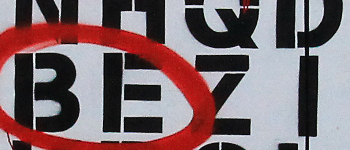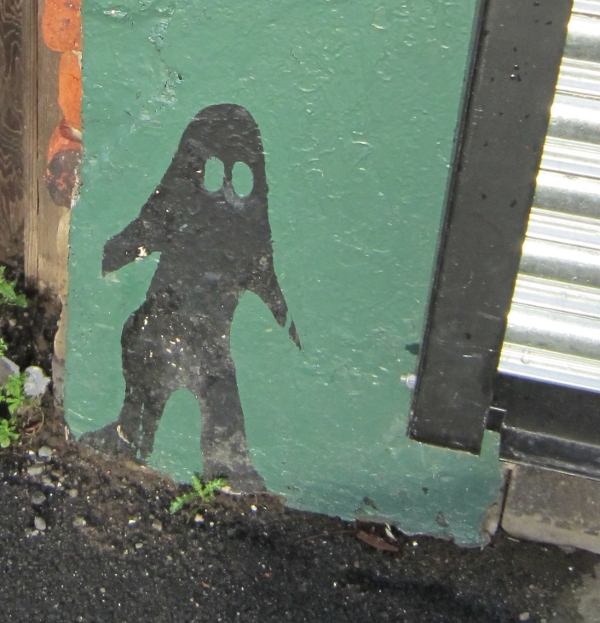At the time of writing, my NaNoWriMo effort stands at 38500 words. So I’m in with a chance even though my plan fell apart like a wet pizza sometime into the second week. I almost walked away from it then. But I’m too stubborn for that even though I had to take a few days out for deadlines. So when I returned to it, with wordcount to make up and no decent plan in place, panic seized me every time I looked at my keyboard. It was time for a new approach. It was time to go meta.
Someone overheard my description of this MetaWriMo trick in a writing workshop this week and jumped to the conclusion that I’m an utterly pretentious wanker. I could see it in her face. Oh well, I have no pride left anyway.
In fact going meta involves merely pretending that you’re an utterly pretentious wanker. You need to tell yourself that suddenly your NaNoWriMo novel has become a postmodern story about the writing of a novel. But wait! It’s just a trick, because you’ll strip out the meta-wankiness when you come to the edit. It’s really just a way of bringing your planning and discovery work into the novel so it can be used as legitimate wordcount.
So here are some MetaWriMo tricks I tried this time round:
1. Take the plunge and redefine your novel
This is the first step, and you really just take it in your head. You know what your novel’s about, right? It’s about a band of experimentally intelligent lab squirrels on quest to find a mythical Golden Nut, is it not? Or a campus feud at Reading University in 1973. Right? Wrong. Whatever your book was about, it’s now about the process of writing a NaNoWriMo novel. This mental twist is your essential first step into the world of MetaWriMo. Once you’ve accepted this, everything else becomes possible. Does this mean you’re abandoning your real novel? Absolutely not. But the process of defining that novel is interesting too. What’s more, it’s useful. You’ll be using your NaNoWriMo novel to learn more about your story, your world, your characters. You’ll learn what works, and what doesn’t. You’ll have the freedom to take risks, and to back up and take them all over again. You’re accepting that writing a novel top to tail isn’t for you, and you’re creating a portfolio you’ll use for your next draft. What’s more, you can’t fail. After all it’s all wordcount.
2. Create a meta-narrator
Your meta narrator exists really to make you feel better about using the NaNoWriMo process for planning and for free writing as well as writing the novel proper. Your meta narrator is your fig leaf and your master of ceremonies.
The meta narrator is a framing device you can use to thread all your story discovery work together so that when it comes time to submit your novel on 30 November, you can say yes, this is a novel. It’s an experimental novel, but a novel nonetheless. The narrator story-izes what might otherwise feel like a collection of notes and exercises.
He’s not necessary to the process, but he’s fun, and you can have him muse about story options, so he can end up making discoveries for you during the writing process.
Have fun with the meta-narrator. You’ll be stripping him out in the rewrite, so you can go crazy. Make him a computer intelligence from the year 2372, or a magic imp.
3. Go meta
Now you can do anything you like, really. The aim is to find out who your characters are, to explore your setting, and to discover where your story is heading. Here are some things I had my meta-narrator introduce when the going got sticky:
a. Write some back story
How did we get here? Trace a scene back into your novel’s pre-history.
b. Interview your characters
There are character interviews all over the internet. There’s a good one right here, too. How many of your NaNoWriMo characters are two dimensional? Story is driven by character, so back up and explore some of your novel’s walk-on parts. Maybe they’ll end up being more important than you thought.
c. Rewrite a scene
Did you hurry through a good bit? Try rewriting it from the top. Think back for likely scenes, and add them to your writing list. Favour scenes in which more detail might add depth, and yield more story branches.
d. Write mutually exclusive scenes
Not sure which way the story should twist at a key point? Have your cake and eat it. Try both. Maybe a character gets killed in one scene. In another version she escapes, and has all sorts of adventures. This is post-modernism. Go and read Lorrie Moore’s Anagrams. You see? Actual real, good, proper novelists do this stuff.
e. Go into what-if mode
Make a list of potential scenes. Don’t think about it too much. Get as many ideas down as you can. Let each idea spark others. Have your meta narrator narrow the field down a bit afterwards. Refer back to this passage when you’re stuck for something to write.
f. Go into setting mode
Rewrite a scene in setting only. Describe buildings, and objects, but nothing else. When the edit comes you’ll be able to bring your layers together. Do the same with smells and sounds. Write scenes in gesture only. If you start to feel guilty about this, have your wanky meta-narrator say something profound and post-modern to justify it.
g. Change the point of view
Write from the point of view of your antagonist. Or rewrite a scene from the perspective of a minor character.
h. When all else fails, skip ahead and write the best bits
There’s something cool about your story, right? There have to be some scenes you’re looking forward to writing. Don’t wait. Write one now. You can shuffle things around later. If you’ve written all the exciting scenes then try section e (above) again, and sketch in some new ones. And remember, you probably rattled through the cool stuff too fast first time round, so don’t be afraid to try them out again.





